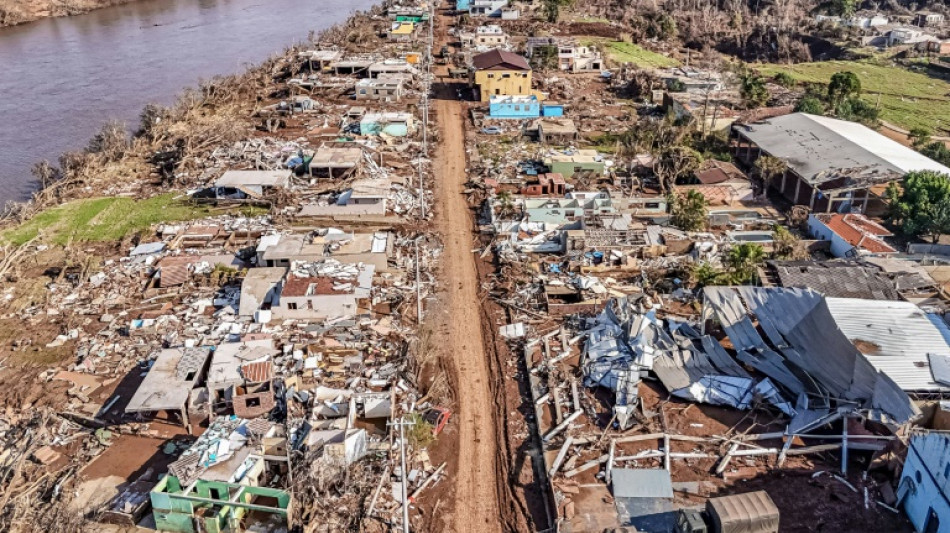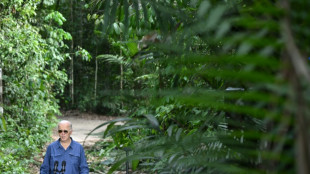
-
 Woman-owned cafe in Indonesia's Sharia stronghold shakes stigma
Woman-owned cafe in Indonesia's Sharia stronghold shakes stigma
-
Indigenous Australian lawmaker who heckled King Charles censured

-
 End of an era as Nadal aims for winning Davis Cup farewell
End of an era as Nadal aims for winning Davis Cup farewell
-
Trump taps big tech critic Carr to lead US communications agency

-
 Mitchell-less Cavs rip Hornets as perfect NBA start hits 15-0
Mitchell-less Cavs rip Hornets as perfect NBA start hits 15-0
-
Markets swing after Wall St losses as traders weigh US rates outlook

-
 India's capital shuts schools because of smog
India's capital shuts schools because of smog
-
Rio under high security for G20 summit

-
 G20 leaders to grapple with climate, taxes, Trump comeback
G20 leaders to grapple with climate, taxes, Trump comeback
-
Hopes set on G20 spurring deadlocked UN climate talks

-
 Gabon early results show voters back new constitution
Gabon early results show voters back new constitution
-
Child abuse police arrest star Australian broadcaster

-
 Disgraced Singapore oil tycoon to be sentenced for fraud
Disgraced Singapore oil tycoon to be sentenced for fraud
-
Stray dogs in Giza become tourist draw after 'pyramid puppy' sensation

-
 UN Security Council to weigh call for immediate Sudan ceasefire
UN Security Council to weigh call for immediate Sudan ceasefire
-
Is AI's meteoric rise beginning to slow?

-
 Israeli strikes on Beirut kill six, including Hezbollah official
Israeli strikes on Beirut kill six, including Hezbollah official
-
Rain wipes out England's final T20 in West Indies

-
 US speaker opposes calls to release ethics report on Trump's AG pick
US speaker opposes calls to release ethics report on Trump's AG pick
-
McDonald's feast undercuts Trump health pledge

-
 Thousands march through Athens to mark student uprising
Thousands march through Athens to mark student uprising
-
NBA fines Hornets' Ball, T-Wolves' Edwards, Bucks coach Rivers

-
 China's Xi says to 'enhance' ties with Brazil as arrives for G20: state media
China's Xi says to 'enhance' ties with Brazil as arrives for G20: state media
-
Bills snap nine-game Chiefs win streak to spoil perfect NFL start

-
 Biden answers missile pleas from Ukraine as clock ticks down
Biden answers missile pleas from Ukraine as clock ticks down
-
Senegal ruling party claims 'large victory' in elections

-
 Dutch plan 'nice adios' for Nadal at Davis Cup retirement party
Dutch plan 'nice adios' for Nadal at Davis Cup retirement party
-
Trump meets PGA boss and Saudi PIF head amid deal talks: report

-
 UN chief urges G20 'leadership' on stalled climate talks
UN chief urges G20 'leadership' on stalled climate talks
-
Steelers edge Ravens, Lions maul Jaguars

-
 No.1 Korda wins LPGA Annika for seventh title of the season
No.1 Korda wins LPGA Annika for seventh title of the season
-
Biden touts climate legacy in landmark Amazon visit

-
 England secure Nations League promotion, France beat Italy
England secure Nations League promotion, France beat Italy
-
Star power fails to perk up France's premiere wine auction

-
 Rabiot brace fires France past Italy and top of Nations League group
Rabiot brace fires France past Italy and top of Nations League group
-
Carsley relieved to sign off with Nations League promotion for England

-
 Sinner says room to improve in 2025 after home ATP Finals triumph
Sinner says room to improve in 2025 after home ATP Finals triumph
-
Senegal counts votes as new leaders eye parliamentary win

-
 Biden clears Ukraine for long-range missile strikes inside Russia
Biden clears Ukraine for long-range missile strikes inside Russia
-
Lebanon says second Israeli strike on central Beirut kills two

-
 Puerto Rico's Campos wins first PGA title at Bermuda
Puerto Rico's Campos wins first PGA title at Bermuda
-
Harwood-Bellis risks wedding wrath from Keane after England goal

-
 'Nobody can reverse' US progress on clean energy: Biden
'Nobody can reverse' US progress on clean energy: Biden
-
NBA issues fines to Hornets guard Ball, T-Wolves guard Anthony

-
 Biden allows Ukraine to strike Russia with long-range missiles: US official
Biden allows Ukraine to strike Russia with long-range missiles: US official
-
Britain dump out holders Canada to reach BJK Cup semi-finals

-
 Biden clears Ukraine for missile strikes inside Russia
Biden clears Ukraine for missile strikes inside Russia
-
Ukrainians brave arduous journeys to Russian-occupied homeland

-
 Australia not focusing on Grand Slam sweep after thrashing Wales
Australia not focusing on Grand Slam sweep after thrashing Wales
-
Wales's rugby woes -- three talking points


Climate misinformation overshadows record floods worldwide
Climate skeptics are scapegoating a weather modification technique known as cloud seeding to deny the role of global warming in historic floods that have recently devastated countries from Brazil to Kenya.
Record rainfall brought to some regions by the natural weather cycle El Nino matches an expected increase in extreme events, experts say.
But online, claims have repeatedly been made that geoengineering –- not carbon emissions –- is to blame.
"Dubai airport looks like an apocalyptic movie. Videos of the flooding are insane," said Robby Starbuck, a conservative American commentator, to his more than 460,000 followers on X in April, after the Gulf city was hit by unprecedented downpours.
"I've seen some blaming climate change when the cause is actually from the use of weather modification. Cloud seeding where chemicals are sprayed in clouds to create rain caused this."
Claims that weather had been manipulated appeared after every major flood this year, including in Zimbabwe, the United Arab Emirates and other nations. According to Google Trends data, searches for cloud seeding reached a record high after the Dubai floods in April.
"I have not agreed to our planet having cloud seeding everywhere, have you?" was typical of posts among X users in late May, blaming the recent rainfall on a "man-made climate crisis."
Cloud seeding, which introduces tiny particles into the sky to induce rain over small geographical areas, has gained popularity worldwide as a way to combat drought and increase local water supplies.
But scientists say the technique cannot create weather -- nor can it trigger rainfall at the scale observed in countries such as Germany and the United States.
"Due to the strong natural variability of clouds, there exists very little scientific proof that cloud seeding has indeed a measurable effect on precipitation," said Andrea Flossmann, co-chair of an expert team on weather modification at the World Meteorological Organization.
Experts, meanwhile, say climate change doubled the likelihood of floods in southern Brazil and worsened the intense rains caused by El Nino.
"There's definitely a consensus that climate change is responsible for many of these extreme weather events," said Mariana Madruga de Brito, a Brazilian scientist from Rio Grande do Sul, the state that suffered historic flooding in May.
She told AFP she saw people posting photos of clouds on social media shortly after the floods, claiming they had been "fabricated" and questioning scientific institutions.
But she insisted cloud seeding "cannot be causing events of this magnitude."
- Reinforcing climate denial -
Di Yang, an assistant professor at the University of Wyoming, said extensive research over several decades has shown "no definitive large-scale or long-term impacts from cloud seeding."
Still, the technique has become a recurring target for climate skeptics. AFP has debunked several false claims of weather manipulation after major floods in recent years.
Callum Hood, head of research at the Center for Countering Digital Hate, said that as severe weather events become more frequent, "climate deniers are putting extra efforts into claiming these extremes have nothing to do with climate change."
"You see this every summer now," he told AFP.
As more changes are recorded in seasons and ecosystems, Hood said "a slightly more conspiratorial and newer argument" is overtaking older narratives that simply deny Earth's warming "by trying to argue that extreme weather events have this other cause, whether it's geoengineering or something else."
Lincoln Muniz Alves, a researcher at the Brazil National Institute for Space Research, said the dissemination of false narratives not only obstructs effective communication during environmental crises but also "reinforces the views of those who deny the reality of climate change."
Weather modification methods are controversial in the scientific community, due in part to the potential for unintended consequences such as excess rain and pollution.
But experts say such caution should not discredit the reality of the climate crisis.
"This focus on cloud seeding misses the larger picture –- for more than a century, humans have been releasing greenhouse gasses (that) have warmed the planet and made heavy rain more likely in many regions of the world," said Edward Gryspeerdt, a research fellow at Imperial College London's Grantham Institute.
"We are already manipulating the weather at a global scale (larger) than would ever be possible through cloud seeding."
N.Mitchell--AT


